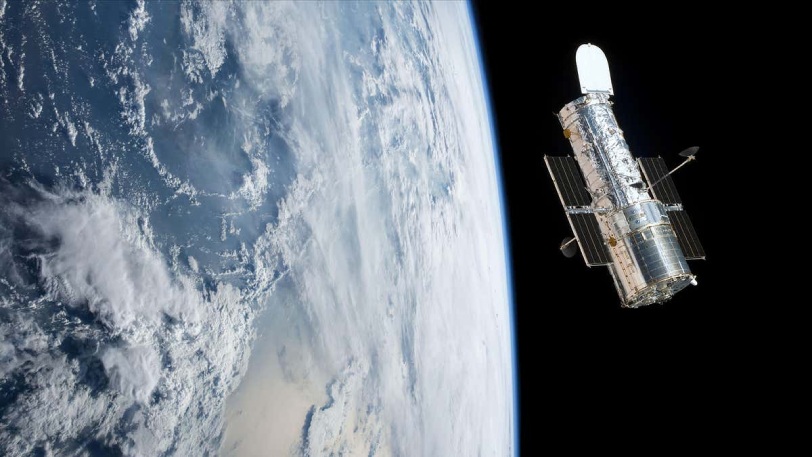History comes further into focus via future telescopes
Fri 01 Oct 2021
Telescopes are time machines. One day, they could take us to a time before starlight. When astronomers peer out into the vast distances of space, they’re also looking back in time. That’s because faraway light takes a long time to reach us.
Just as experts study fossils on Earth to understand past eras, they can chart the evolution of the cosmos by looking at starlight of various ages — but there is a limit to how far back in time we can see.
The Hubble Space Telescope, which is orbiting the Earth right now, can see 13.3 billion years back in time. Its successor, the James Webb Space Telescope, will be able to peer even farther back in time than the Hubble after it is launched in December.
“We are looking for the first light that turned on at the very beginning of cosmic time,” says Caitlin Casey, a UT Austin astronomer who has been approved to use the Webb to look for this light.
This is a historic quest. We as humans have never before had the technology to see this first light. It will teach us a lot about how our universe formed, and why it looks the way it does today.
But even this first starlight does not signify the beginning of time. The Big Bang occurred hundreds of millions of years before starlight during which time the universe was shrouded in darkness. And with no light, there’s nothing for existing telescopes to observe.
The James Webb Space Telescope can see back to the first stars and galaxies, but it will be blind to the cosmic dark ages and the Big Bang.
“When the universe was first created, it was so hot after the Big Bang, atoms couldn’t exist,” Paul Hertz, NASA’s director of astrophysics explains. “It was just a plasma of subatomic particles,” he adds.
There’s no light shining through to us from this extreme early universe because light simply cannot travel through a plasma of particles tinier than atoms. Any light that existed then “would just go a very short distance before it would be scattered off some subatomic particle,” Hertz adds.
Eventually, years later after the Big Bang, this plasma cooled and a bit of light broke through. Experts call this light the cosmic microwave background — essentially the afterglow of the Big Bang — and observatories can see it in very dark places like Antarctica, the Atacama Desert, and in Earth’s orbit.
Back in the dark ages, the universe “was full of hydrogen and helium atoms and nothing else,” Hertz says. “And there was nothing to emit light. So it was still dark.”
What’s more, that hydrogen formed “a dense, obscuring fog of primordial gas,” as the National Science Foundation explains. If there was light anywhere, it would be shrouded in the fog.
During the dark ages, astronomers believe, the hydrogen that pervaded the universe emitted very faint radio waves. And that gives astronomers some hope. “You could look back into the dark ages because those atoms were giving off radio waves,” Hertz says.
It’s as though they were broadcasting a lonesome signal from near the beginning of time, which could make it through the fog.
“If you build the right kind of radio telescope, very large, very sensitive, then you would be able to detect the radio waves and we could study the universe before the first stars and first galaxies,” Hertz says.
There are a few concepts for putting a telescope on the far side of the moon. One is called Farside. This one is the Lunar Crater Radio Telescope, which would nestle the observatory in a moon crater. Saptarshi Bandyopadhyay/NASA Jet Propulsion Laboratory
But we can’t detect these faint radio waves from Earth. All the radio transmissions that are produced on Earth would drown them out.
This is where the moon comes in — as a kind of giant shield. The moon is “thousands of miles of rock, so the radio waves can’t get through that,” Hertz explains. The far side of the moon is quite enough for us to listen in.
Right now there are a few concepts for these moon telescopes, from one that nestles the telescope in a crater to ones that involve lunar rovers. There are currently no concrete plans to build and launch one.
Still, even a giant radio telescope on the far side of the moon could only take us so far. It couldn’t take us back to the Big Bang when the universe was just a dense plasma of particles.
Currently, NASA and the European Space Agency have plans for a space-based gravitational observatory called LISA (the Laser Interferometer Space Antenna), to launch in 2034. It will be a constellation of three satellites that form a triangle, with each side measuring a whopping 2.5 million kilometers.
“It measures whether the distance between the satellites has changed,” Hertz explains. “And if it changes, it’s because a gravitational wave went by and shrank or expanded space.”
The Webb Space Telescope will generate incredible images that are only going to inspire more people to get interested in science, to be curious about the universe they inhabit. Those people may dream up the next barrier-breaking telescope, and the cycle will continue.
There will never be one ultimate telescope that can see everything humans want to see. “Each telescope, whether it’s on Earth or in space, is designed to do a particular kind of science,” Hertz says. Even the mighty LISA, capable of peering back to near the very beginning of time, would be blind to some things, like starlight. Other future telescopes might not set their gaze on the beginning of time, but rather on the many planets that revolve around other stars, as they search for another Earth.
“We’re just a bunch of humans floating on a rock through space,” Casey says. “It’s wild, when you think about it, that we’re able to even piece together what happened before the Earth or the sun even existed,” he adds.
Source: Agencies

 Apr 19 2024
Apr 19 2024













